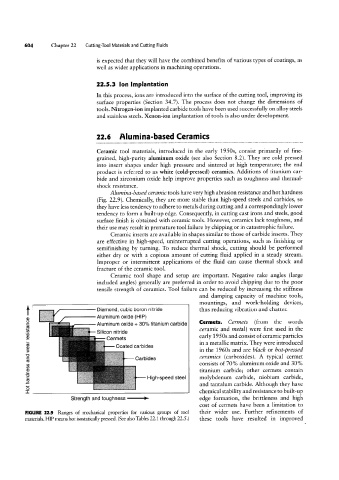Page 623 - 04. Subyek Engineering Materials - Manufacturing, Engineering and Technology SI 6th Edition - Serope Kalpakjian, Stephen Schmid (2009)
P. 623
0 Chapter 22 Cutting-Tool Materials and Cutting Fluids
is expected that they will have the combined benefits of various types of coatings, as
well as Wider applications in machining operations.
22.5.3 lon lmplantation
In this process, ions are introduced into the surface of the cutting tool, improving its
surface properties (Section 34.7). The process does not change the dimensions of
tools. Nitrogen-ion implanted carbide tools have been used successfully on alloy steels
and stainless steels. Xenon-ion implantation of tools is also under development.
22.6 Alumina-based Ceramics
Ceramic tool materials, introduced in the early 1950s, consist primarily of fine-
grained, high-purity aluminum oxide (see also Section 8.2). They are cold pressed
into insert shapes under high pressure and sintered at high temperature; the end
product is referred to as white (cold-pressed) ceramics. Additions of titanium car-
bide and zirconium oxide help improve properties such as toughness and thermal-
shock resistance.
Alumina-based ceramic tools have very high abrasion resistance and hot hardness
(Fig. 22.9). Chemically, they are more stable than high-speed steels and carbides, so
they have less tendency to adhere to metals during cutting and a correspondingly lower
tendency to form a built-up edge. Consequently, in cutting cast irons and steels, good
surface finish is obtained with ceramic tools. However, ceramics lack toughness, and
their use may result in premature tool failure by chipping or in catastrophic failure.
Ceramic inserts are available in shapes similar to those of carbide inserts. They
are effective in high-speed, uninterrupted cutting operations, such as finishing or
semifinishing by turning. To reduce thermal shock, cutting should be performed
either dry or with a copious amount of cutting fluid applied in a steady stream.
Improper or intermittent applications of the fluid can cause thermal shock and
fracture of the ceramic tool.
Ceramic tool shape and setup are important. Negative rake angles (large
included angles) generally are preferred in order to avoid chipping due to the poor
tensile strength of ceramics. Tool failure can be reduced by increasing the stiffness
and damping capacity of machine tools,
mountings, and work-holding devices,
DiamOI"\d, cubic bOr0n nitride thus reducing vibration and chatter.
Aluminum oxide (HIP)
Aluminum oxide + 30% titanium carbide Cermets- Cermets iffonf the Words
ceramic and metal) were first used in the
Silicon nitride
Cermets early 1950s and consist of ceramic particles
in a metallic matrix. They Were introduced
Coated carbides
in the 1960s and are black or hot-pressed
Carbides ceramics (carboxides). A typical cermet
consists of 70% aluminum oxide and 30%
titanium carbide; other cermets contain
High-speed steel molybdenum carbide, niobium carbide,
and tantalum carbide. Although they have
chemical stability and resistance to built-up
rength and toughness-l> edge formation, the brittleness and high
cost of cermets have been a limitation to
FIGURE 229 Ranges of mechanical properties for various groups of tool their Wider use. Further refinements of
materials HIP means hot isostatically pressed. (See also Tables 22.1 through 22.5 .) these t00l5 have resulted in improved

